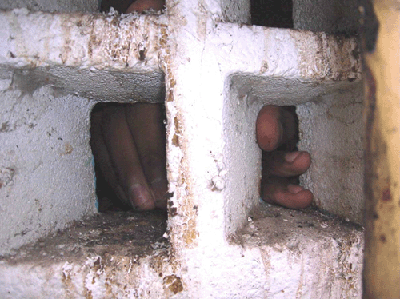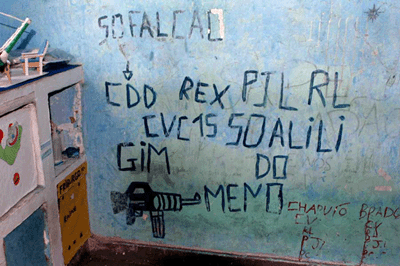"Sometimes I was too scared to sleep. [At night] you can shout and shout and shout and [the guards] don’t do anything."
"If you really step out of line, at night time the staff form a corridor. They each pick up a piece of wood and the kid has to pass through the tunnel [whilst being beaten]. The name of the piece of wood is Kelly Key; she had a pop song that went ‘bye-bye baby, bye-bye’. When it gets to the last bit someone gives you a big f***ing smack."
This month, July 2005, Brazil’s juvenile justice law, the Statute of the Child and the Adolescent (ECA), celebrates its fifteenth anniversary. In theory it is a model law, going far beyond most existing international legislation. Yet according to a report released last month by Human Rights Watch (HRW) the Statute represents a "hollow promise" to the 900 youths incarcerated in the city of Rio de Janeiro. Another report launched this week by the Mothers’ Movement to Guarantee the rights of teenagers in the Socio-educational system (MOLEQUE) underlined why. "The young people are welcomed [to the units] with punches and are exposed to sadistic welcome rituals," it described. "Torture is generalized."
Social workers and psychologists are becoming increasingly worried about cases of post-traumatic stress in hundreds of young people like Wellington, who have been locked up in these units.
"[These young people] experience ritual humiliation from the very moment of their arrest," said psychologist Patrícia Tolmasquim, who coordinates the ‘Olhe Pra Mim’ (Look at Me) project for street kids, many of them ex-internees, in Rio’s south zone. "When they come out their communication is completely stunted. They won’t look at you straight, or they’ll look through you, or away from you. Verbal communication is virtually nil and when they do communicate it is with a complete lack of control. They become very untrusting, as if they identify you with something inside the institution."
The HRW report catalogues a gruesome list of abuses in Rio’s often run-down Socio-educational Institutes, including ritual beatings, sexual abuse and inadequate medical facilities.
The Department of Socio-Educational Action or DEGASE, the body in charge of the units, was quick to reject the report.
"In all frankness that report was full of lies," said Vanísia Maia, a DEGASE technical director.
"I repudiate [the HRW report]. Not even 10 per cent of that is true," added Petrer da Costa, the director of Padre Severino.
But former internees, unrelated to the HRW report, told Toward Freedom of abuses identical to those denounced by the human rights group.
According to the ex-internees, staff at Padre Severino often disconnected the water supply as a form of punishment. Beatings and violence between the teenagers themselves are also said to be common.
Despite this, senior members of DEGASE continue to reject allegations of physical abuses.
"The boy who comes from outside, without any kind of limit [on his behavior] arrives in the unit where there are normas [rules]. This, for them, is a torture. They can’t use marijuana and for this boy the agent becomes a torturer," said Carlos Alberto Oliveira, the senior DEGASE director, with responsibility over the units at the Ilha do Governador.
"These accusations are all fantasies," he added.
For the families of the inmates, however, the violence is all too real.
"Inside these institutes the conditions are horrific," says the mother of one former detainee, who refused to be identified for fear of reprisals. "These places are veritable human deposits. Instead of being about education these places are about punishment."
"On arrival these boys are put in a queue and beaten, they are slapped in the face or on the legs. In Padre Severino I knew of a guard who would get on the table at dinnertime and spit in the plates [of the boys]."

Entering through the thick walls of Padre Severino it isn’t hard to see why the Institute has become so notorious. The odor of stale sweat and cheap detergent hangs in the air. Queues of young boys file past silently, hands clasped timidly behind their backs. Besides the cellblock an abandoned swimming pool stagnates in the afternoon sun. Nobody knows when the last time anyone swam in it was – sunbathing is banned due to a lack of staff. The sound of Padre Severino’s 260 inmates, crammed into ten fetid cells, echoes eerily around the building.
We asked repeatedly to be allowed into the dormitories at Padre Severino, where around 260 teenage boys are held in a space intended for 160. Repeatedly the unit’s director, Petrer da Costa, refused. "We cannot guarantee your security," he said. "It’s not even worth you staying here until midnight, you won’t be able to go in."
Instead Toward Freedom conducted interviews with a number of the inmates through a series of crumbling grates that offer the only source of light in the cells. Crouched over in the stagnant, mosquito ridden puddles that flank the cellblock and peering into the dungeon-like rooms one gets a dimension of the conditions in which Padre Severino’s internees are forced to live.
Starring out from the darkness the internees said the room was full of cockroaches and "ratões" (huge rats) that constantly urinated on their mattresses. The sound of dripping water filtered through the tiny grills.
"Lots of us have to share single mattresses," said one 14-year-old boy. "It gets so hot in here sometimes, it’s unbearable."
Yet when the unit’s director came within earshot, the stories changed. "It’s cool here. The director is a cool guy. We get to play football."
With the MOLEQUE report launched on Tuesday at Rio’s Legislative Assembly (ALERJ) government officials are beginning to admit the extent of the violence in Rio’s detention centers.
"We know that this [abuse] is happening. We can’t pretend it’s not, even though there might not be any proof," said Dr. Evandro Steele, the State Secretariat for Childhood and Youth’s sub secretary.
According to Dr. Steele, one of the greatest problems is that the authority directly in charge of such units, DEGASE, also controls the ombudsman supposed to investigate internal abuses. Dr. Steele has asked Rio’s governor, Rosinha Matheus, to bring the watchdog under the control of the Secretariat.
"The ombudsman is fundamental. If you have a strong and independent ombudsman that is not subordinate to Degase then the system would be a lot better," he said.
In the meantime the abuses continue. Ex-internees told Toward Freedom of another punishment method, not mentioned in the HRW report, by which agents beat the teenagers with a thick piece of wood, nicknamed ‘Faustão’ after the fat Brazilian television presenter. An array of other grisly stories circulated about the treatment and disappearance of teenagers in Rio’s youth detention centers.
Like Brazil’s prisons, Rio’s youth detention centers are infused with the drug factions that dominate many of the city’s 600 favelas or shantytowns, from where the overwhelming majority of internees come.
Unofficially, Padre Severino is divided into two flanks; one which houses teenagers from communities controlled by the Comando Vermelho (Red Command), and another for those from Terceiro Comando or Amigos dos Amigos areas.
"They all do the activities together [during the day]. But at night we can’t take the risk of leaving them together," explains Oliveira.
"We cannot close our eyes [but we can’t accept it either]. So when they are in the living area they are separated."
Anthropologist Luke Dowdney, who works for the NGO Viva Rio believes this separation only serves to exacerbate an already bad situation.
"Due to this lack of integration, numerous internal conflicts have occurred. For example, in March 2002, a group of faction members killed an adolescent from a rival faction," he described.

At the two units visited by Toward Freedom, signs of affiliation to drug factions were everywhere. In one room, at the João Luiz Alves centre, a machine gun had been painted on to one of the walls, alongside the initials of the Red Command gang (CV) and one of its founders, Rogério Lengruber. Elsewhere tributes were paid to the drug gangs in charge of other communities in Rio, like Cidade de Deus (CDD or City of God).
Stretched to breaking point, many of the agents working in Rio’s detention centers also live in a climate of constant fear. On the day of our visit, 12 agents were in charge of 260 teenagers at Padre Severino. The director said at least thirty were necessary to guarantee security.
"We can’t let them perceive the fragility of the place," said Oliveira. "What would happen if they did pick up on this? An attempted rebellion or escape."
The ‘agentes’ [guards], who receive just R$1500 (US$750) each month, have seen their numbers slashed since last year, after 300 agents were removed from their posts because of recruitment problems. Dr. Steele believes this has created a "situation of emergency" across the city.
At the Padre Severino, the institute’s director leads us into a classroom, where a group of teenage boys are being taught. Each boy holds a packet of biscuits and a carton of soft drink.
"This is why I get really angry when new organizations criticize us in this way," said Oliveira. "DEGASE does so many good things that are not picked up on by the press"
He points to the children, silently munching away on their biscuits, and talks about the Peace Olympics put on each year in Rio’s gigantic Maracanã football stadium for the teenagers.
"[To work here you have to have] the commitment to the socio educational cause," he said.
Yet just feet away teams of half-naked teenagers are packed into the unit’s squalid cells, forced to sleep head to toe on single mattresses in stifling heat. In these surroundings it is not just physical abuse that is endemic but also skin complaints like scabies.
"A philosopher once said that we can see what a society is like from how it treats its young people and its elderly," said Ricardo de Gouvêa Corrêa, from the Bento Rubião Human Rights Foundation, at the launch of the MOLEQUE report.
"In this context Rio society, and that of Brazil as a whole, would not get a good mark. It is inconceivable that the torture of young people [in these institutes] should be occurring as is the case in Rio de Janeiro."
"Our young people are dying," added Mônica Suzana one of the directors of MOLEQUE. "In the past all we used to see were mothers crying outside the units’ gates At least now they [DEGASE] know we have our eyes on them, and that we won’t let these abuses go unpunished."
Photos are by Tom Phillips. He is a freelance journalist based in Brazil.
